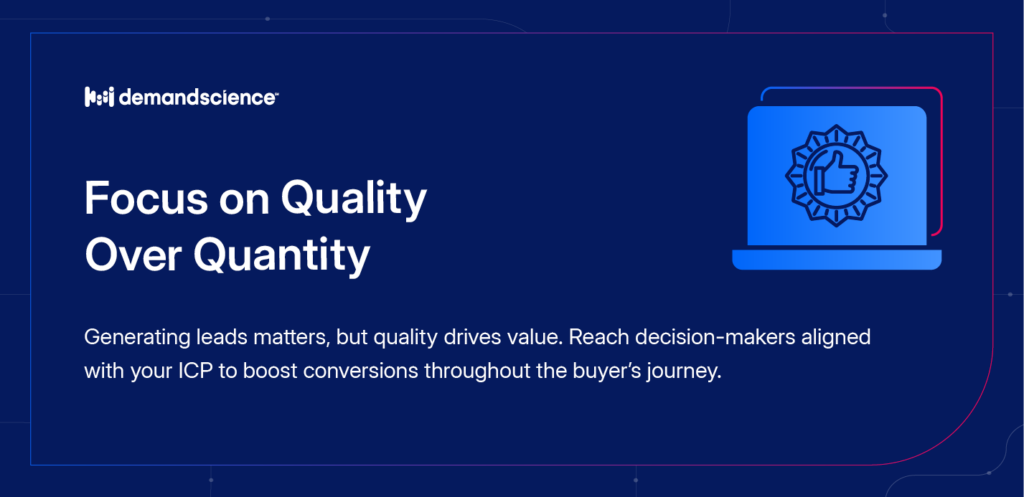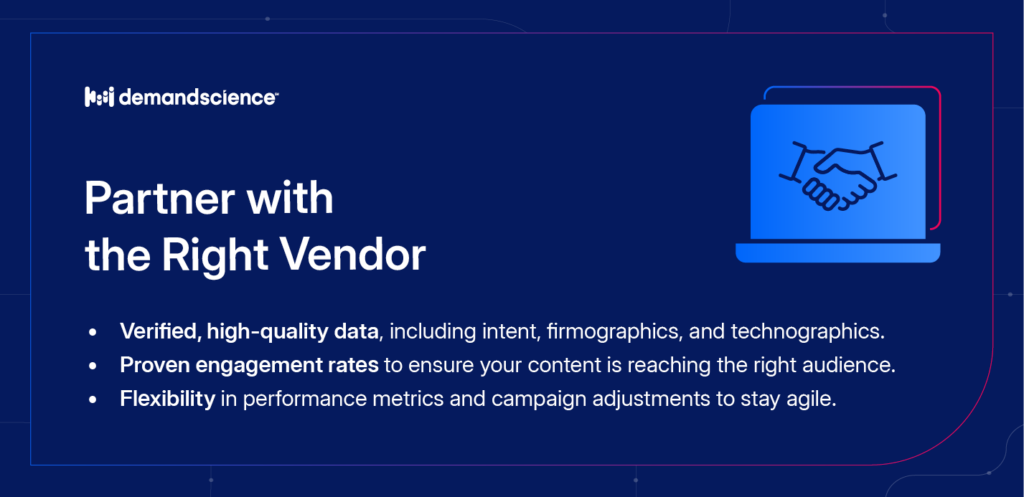What is Content Syndication? The Key to Generating Leads and Increasing Conversions
February 20, 2024

Content syndication can help turn your best content into a powerful lead generation tool. It is a marketing methodology that allows you to get your content in front of a much larger audience than you would if you simply posted that same content to your website. Your ebook, whitepaper, report, checklist, or webinar can then be used to educate, engage, and qualify leads before they even visit your website for the first time.
For B2B sales and marketing teams, content syndication isn’t just a way to attract more leads, but the right kinds of leads. It is not just a marketing fad; it’s a strategy that’s being used by many B2B companies with great success. IntoTheMinds found that 65% of B2B marketers scale their content marketing efforts with content syndication and experienced an increase in reach.
However, it’s not just about the numbers. The real success of content syndication lies in the quality of the leads it generates. B2B content syndication can help businesses reach highly targeted audiences, leading to more qualified leads and higher conversion rates.
What is Content Syndication?
Content syndication refers to the strategic republishing of content in more than one location. In the context of B2B marketing, that means partnering with other websites, sharing content on social platforms, and promoting content on syndication networks. Content syndication is the process of distributing your content in a range of ways to reach your target audience.
In many ways, it’s a combination of content marketing and sales prospecting. Most people use content syndication to source relevant, vetted marketing-qualified leads (MQLs) for their sales teams. Bear in mind that these MQLs will require a fair amount of nurturing—18-24 touches, in fact—before they’re ready to convert.
The concept behind content syndication is simple: it’s about expanding the reach of your content. It’s a bit like a newspaper or a magazine, allowing other publications to reprint their articles. The internet has made content syndication much more accessible and widespread, with many businesses and websites now utilizing this strategy to maximize their online presence. It’s important to understand that content syndication is not a shortcut or a way to duplicate content. It’s a strategic move that should be done carefully, following best practices to avoid penalties related to SEO.
Who Uses Content Syndication?
Content syndication is nothing new; large websites, magazines, and other widely distributed media use syndicated content provided by smaller publications all the time.
For example, a news website might syndicate articles from other news outlets to provide comprehensive coverage of a certain topic or event. By doing so, they can keep their readers engaged and stay competitive in the ever-evolving digital media landscape.
There’s also the case where online communities practice syndicating content. Forums and aggregators, such as Medium, Reddit, and Quora, are platforms that thrive on user-generated and syndicated content. These platforms curate and distribute content from various sources to cater to the specific threads and conversational preferences of their user base. As of writing, Reddit has the most subreddit communities where users share and discuss content on specific topics by sharing and linking existing content as their sources, creating a vibrant ecosystem that drives engagement and fosters a sense of community.
It is worth noting that content syndication is not limited to these three groups. The practice of content syndication offers benefits to anyone looking to broaden their content distribution, increase visibility, and engage a wider audience.
How Content Syndication Addresses This Specific B2B Challenge
Having limited visibility can have a detrimental effect on a company’s lead generation efforts, brand recognition, and overall marketing effectiveness. When B2B companies have limited visibility, it painfully means your target market doesn’t have any idea you exist. This lack of awareness can result in missed opportunities, decreased brand recognition, and ultimately, lower sales.
When potential customers are not aware your products/services exist, you are unable to generate interest, or technically, you are unable to garner traffic. This leads to a lack of inbound leads, making it more challenging for your sales team to hit their goals.
With this being said, the challenge of being visible on the B2B landscape impacts all your B2B marketing campaigns and their effectiveness. Think of it this way, no matter how loud you try to be, if your efforts are not reaching the right audience or are not being seen by enough people, the return on investment (ROI) for those campaigns will likely be low. You are wasting your effort, time, and resources.

Resources that could have been better utilized in more marketing distribution effort that has a way to get your materials in front of the right eyeballs. Remember, merely running social ads does not guarantee long-term visibility and retention in the B2B market.
Content syndication helps you overcome this challenge. By syndicating your content, you can distribute their valuable materials to not just a wider audience but also the right people who are likely to convert.
What are the Benefits of Content Syndication?
You might be thinking, “My content already generates consistent traffic, why should I bother with content syndication?”
Consistent traffic doesn’t equate to readiness.
Having traffic is a great start for your content marketing efforts, but don’t stop at that.
Relying on the possibility of your target market clicking on your content as they search for a specific query is a long game of hitting walls, and this is already considering that your content is already ranking for that specific key phrase. You can shorten the buying cycle when you understand when and where to present your content materials.
When you syndicate content, you can directly send your valuable content to your email subscribers to clients and even tailor your distribution depending on which stage of the sales funnel your clients are in.
See how content syndication goes beyond these manual approaches to content marketing. It bridges the gap between lead nurturing and lead conversion with a more proactive approach. By using content syndication, you can start matching your best content with the most relevant prospects for your business who are in the market for your solutions.
Content Syndication Benefits
- Scalable ROI. Content syndication will boost the return on investment of your content by using it to funnel leads into your pipeline. Also, you can plan it out far in advance and align it with your growth goals as an organization. Lastly, it can save you time and resources. Creating high-quality content is time-consuming and often expensive. By reusing your best content, you can maximize your ROI while still providing valuable information to your audience.
- Brand engagement. By having your content published on multiple sites, you increase the chances of your content being discovered by new audiences. This can lead to more traffic to your website, and potentially, more conversions. This wider exposure helps to scale awareness of and engagement with your brand. Best of all, it’s a solution for both marketing and demand generation teams.
- Customizable Audience. Content syndication can be tailored to address your specific audience of buyers, eliminating the risk of unqualified leads entering your sales funnel.
- SEO. When your content is syndicated on reputable sites, it often includes a link back to your website. These backlinks can improve your site’s search engine ranking, making it easier for potential customers to find you. Additionally, syndicating your content can establish you as a thought leader in your industry. By having your content distributed on various platforms, you increase your credibility and authority in your field.
How Does Content Syndication Work?
Once you understand the benefits of targeted content syndication, you’ll want to consider the best approaches to getting started with this powerful lead gen channel.
Organic Content Syndication
You can try to build syndication capabilities internally, of course. In addition to the resources it requires to produce quality content driven by powerful storytelling, you’ll need to create tools, methods, and contacts to distribute your content to a broader audience. Many companies do this via their existing email marketing platforms and lists.
Content syndication follows a relatively straightforward process. Firstly, you need to identify the content that you want to syndicate. This could be your most popular blog posts, informative eBooks, or engaging videos. The key is to choose high-quality content that offers value to the readers.
Next, you need to find websites or platforms that are willing to syndicate your content. This could involve reaching out to industry blogs, news sites, or content syndication networks. It’s essential to choose sites that align with your brand and target audience to ensure the success of your syndication efforts.
Once you’ve found a suitable partner, the next step is to agree on the terms of the syndication. This could include how the content will be credited, where the backlinks will point to, and how often the content will be published.
After the syndication process is agreed upon, your content will then be published on the chosen platforms. It’s important to regularly monitor and analyze the performance of your syndicated content to understand its impact and make necessary adjustments.
Choosing Paid Content Syndication
Paid content syndication is when you pay to promote your content to your ideal audience. Paid content syndication will increase the reach of your content and, when done correctly, can increase the ROI of your content by turning it into fuel for lead generation.
If you’ve tried the free route to lackluster results, it’s worth researching paid content syndication options. Especially in the B2B space, where the timing of connecting with the right buyers at the right time can be more than a little challenging. The key, of course, is selecting the right partner. Content syndication networks can help you distribute content to innumerable news and blog sites within their respective network.
How Paid Content Syndication Works
While it will vary from vendor to vendor, you should be able to do the following with any paid content syndication partner:
Here’s how paid content syndication typically works:
- Content Creation: The first step is to create high-quality, engaging content that is relevant to your target audience. This can include articles, blog posts, videos, infographics, or any other form of content that aligns with your marketing goals.
DemandScience works closely with you to understand your goals, target audience, and key messaging. Together, you develop a content strategy that aligns with your marketing objectives. - Content Distribution: Once the content is created, you need to find suitable platforms or websites for syndication. These can be industry-specific websites, content recommendation networks, or content discovery platforms.
DemandScience leverages its vast network of publishers and platforms to distribute your content. They identify the most relevant and influential channels, ensuring that your content reaches the right audience at the right time. - Platform Selection: Depending on your target audience and goals, you need to carefully select the platforms that align with your content and audience. Different platforms may have varying pricing models, targeting options, and audience reach. It’s important to research and choose the platforms that best fit your needs.
- Budget Allocation: Allocate a budget for paid content syndication. The cost will vary depending on the platform, targeting options, and the reach you want to achieve. It’s essential to set a realistic budget to ensure a successful syndication campaign.
- Content Promotion: Once the platforms are selected and the budget is allocated, you can start promoting your content. Some syndication platforms use a pay-per-click (PPC) or cost-per-click (CPC) model, where you pay for each click that your content receives. Your content will be displayed as sponsored or recommended content on the selected platforms, attracting users’ attention and encouraging them to click through to your website. Others use a Cost-per-lead (CPL) model, in which each instance of downloading your content is considered a lead because it requires a form submission.
- Tracking and Optimization: It’s crucial to continuously track the performance of your syndicated content. Monitor the number of clicks, click-through rates (CTR), and engagement metrics. This data will help you optimize your campaign by adjusting targeting options, refining your content, or tweaking your budget. DemandScience provides comprehensive tracking and analytics reports, allowing you to measure the performance of your syndicated content. This data helps you understand the impact of your content and make informed decisions to optimize future campaigns.
What are the Differences Between Organic and Paid Content Syndication
Organic content syndication involves manually reaching out to other websites or blogs and asking them to republish your content. This method of free content syndication requires more time and effort but is often more cost-effective, and allows for more control over where your content is published. You might mistake this approach as the distinguished link building strategy: guest blogging/guest posting, but it isn’t.
Read: Content Syndication vs Guest Posting
Paid content syndication involves using a service to distribute your content to various websites. It guarantees a broader reach of your great content, and with the right content syndication partner, you will also have one hand on the steering wheel while your content materials reach the right client base. However, to maximize the benefits of paid content syndication, it’s important to ensure that your content is high-quality and relevant to your target audience.

Choosing the Right Content Syndication Solution
Choosing the right content syndication service is crucial for the success of your content syndication strategy. Here are some factors to consider when choosing a service:
- The reach of the service: Check the size and relevance of the network of websites and blogs that the service can distribute your content to.
- The cost: Compare the cost of different services and consider the potential return on investment.
- Reporting and analytics: The service should provide detailed reporting and analytics to help you measure the success of your content syndication efforts.
- Customer service: Look for a service that offers excellent customer service and support.
Get Started with B2B Content Syndication
DemandScience is a leading provider of B2B content syndication. We have a wide network that ensures broad distribution of your content. With our advanced targeting options, you can reach specific audiences based on industry, job title, and more. This can increase the likelihood of reaching potential customers and generating qualified leads. As for success measurement, we provide transparent and detailed reporting and analytics, providing you with a content syndication partnership that actively journeys for betterment and success. DemandScience is there with you throughout each step. With our excellent client experience, we are there to support and provide assistance and guidance throughout the content syndication process.
Conclusion
Content syndication is a powerful marketing strategy that can help you drive traffic, generate leads, and increase conversions. Whether you choose to pursue organic or paid content syndication, it’s crucial to create high-quality content and choose the right syndication partners. With the right approach, content syndication can help you reach new audiences, establish your brand as a thought leader, and ultimately, grow your business.
Let’s start exploring the opportunities that content syndication can offer your B2B business together.










